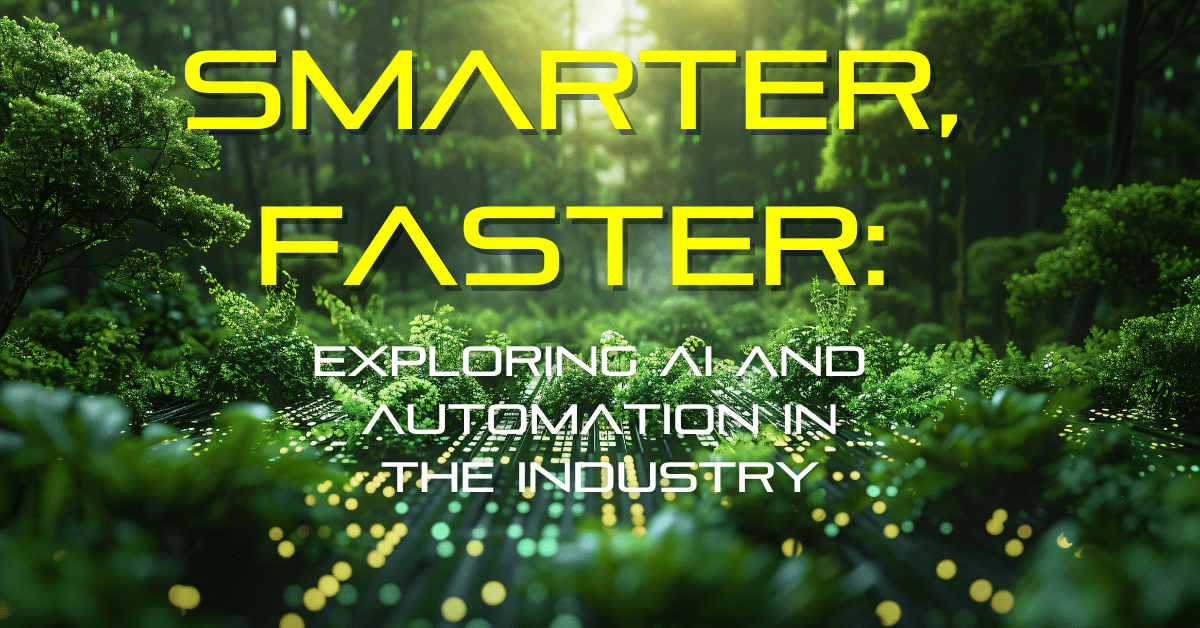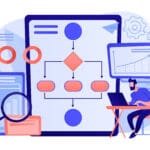
AI and automation can be indispensable tools for lawn and landscape companies looking to do more with fewer people. While they can seem like daunting concepts to integrate into operations, many companies in the landscape industry are already reaping the benefits of being early adopters.
Where AI and Automation Excel
When considering where your business would most benefit from automation, consider repetitive, low-skill tasks such as data entry.
“When you look at automation generally, how you should approach it starts with the efficiencies,” says Adam Swank, director of technology for Ground Works Land Design, based in Cleveland, Ohio. “Mundane tasks are the easiest thing to look at.”
Swank says they have created automations that take care of necessary backend work freeing up their employees to focus on more meaningful tasks.
“In the past, every time we sold a project or we got a new customer for our maintenance department someone would have to go into our GPS system and put in that customer’s address,” Swank says. “Now, as soon as we close a deal on our CRM, that address and that customer gets automatically created in our GPS system, so that record’s there. That’s taking a whole step away from our account manager or sales rep from updating a system, which ultimately is just taking an address and copying it over.”
Similarly, Justin White, owner of K&D Landscaping, Inc., based in Watsonville, California, says they are mostly using automation on the administrative side, allowing their accounting team to do more with the same amount of people on their team.
“One of my mindsets is because we are growing so fast, we’re growing 25-30% a year, our goal is to grow while keeping the same amount of people,” White says. “So instead of hiring that third accounting person, the idea is we’re hiring AI instead of another person that allows us to pay our existing team a little bit more to do more with really the same amount of hours.”
K&D Landscaping also has a handful of subscriptions to the paid version of ChatGPT.
“That allows them to basically try to automate a lot of their complicated formulas, like plant spacing and stuff like that,” White says. “They used to have to do things manually. So they’ll use that for a lot of math. They’ll also use it for generating ideas around designs or proposals just to help kind of fine-tune a lot of our proposals and our outgoing messages.”
AI and automation are also helpful in recruiting and training employees. Dani Gowda, human resources manager with Dennis’ 7 Dees, based in Portland, Oregon, says they use various levels of automations in their applicant tracking system as Team Engine allows them to customize their automations per position. This includes receiving an automated email/text confirming receipt of their application and a text/email with a link if the applicant didn’t enter information like past jobs.
“They receive automated reminders when interviews are scheduled and can respond No to cancel an interview, which has reduced our no shows,” Gowda says. “After a new hire has worked 30 days, they receive a text asking to provide one thing that we could do to improve the training and onboarding process.”
Skyler Westergard, learning and development specialist at LandCare, LLC, based in Frederick, Maryland, says the company has started using AI to help develop employee training content.
“It’s pretty incredible,” Westergard says. “Even just the free version that you can get is pretty astounding. For me, I will use ChatGPT just to help me in my day-to-day work. I like to think of it as a really smart, fast assistant, and my personal assistant that pretty much doesn’t cost me anything.”
Westergard says he will use ChatGPT to help brainstorm or simplify information based on the data he supplies. He explains that the AI doesn’t replace him; it just helps him work more effectively.
Benefits of AI and Automation
The main benefit of AI and automation is the amount of time it saves.
“It frees me up as a human being able to do the thing that I can do and maybe only a human can do, like have an emotional connection with another person,” Westergard says.
Colin Bemus, president of Bemus Landscape Inc., based in San Clemente, California, says they are utilizing automation in every possible way, as it streamlines things and helps them create standards across their organization. He estimates it saves them about 4% in labor and overhead costs.
Swank says it’s important to measure the amount of time saved with automation. With all the different software Ground Works uses, they performed 45,000 different automation.
“Those add up, maybe attribute one minute that’s 45,000 minutes,” Swank says. “That’s 700-something hours; break it down over a 40-hour workweek. Now you’re talking about months.”
Swank says this gained time has allowed them to focus on improving other areas of their business.
“Specifically for us, we felt we had a lot of room for improvement with our hiring and onboarding and more internal processes,” Swank says. “We were able to free up and then reflect on what we were doing now and then how can this get better.”
He says they’ve transformed their hiring process into something similar to a sales pipeline where offer letters can get automatically created. They can use e-signatures, whereas previously, they used fillable PDFs that had to be manually entered into the system.
Gowda says their ATS automation saves them five hours per week and their staff can focus on tasks requiring a personal connection.
Swank says streamlining processes with automation allows employees to engage in work that feels more fulfilling rather than mundane tasks that bog them down, like sales documentation.
White says because they’re in the early investigation phase, they haven’t saved a lot of time yet.
“We’re kind of throwing a bunch of different fishing poles in the water and seeing what fish come up,” White says. “So once we figure out where the fishing hole is, and what fishing bait to use, and then we figure out the system, I think it’s going to save our admin team around 15 to 20%.”
For instance, AI can aid with takeoffs, but K&D doesn’t trust it yet, so they’re comparing results with the old-fashioned way.
“We’re still kind of double dipping because we’re not fully trusting the AI capabilities, which I believe that’ll change in the next six to 12 months,” White says.
White says automation helps centralize your processes if you have a branch model. Using AI can also help you analyze and process your data.
Risks of AI and Automation
However, a balance must be struck when tapping into these types of technology. Not everything should be automated.
“There’s a place for AI and there’s a place for what I call emotional intelligence,” Swank says. “People don’t want to sign $300,000 away to AI chatbot. They want to feel like they trust you. They want to be able to feel that relationship a little bit.”
The sales process, in particular, is best left to the human touch. While automated emails during the middle of the process to keep the client informed are fine, White and Swank stress the importance of starting and finishing with personal interactions.
“If you’re too transactional to automated, they don’t have anyone to refer, they just have a product or a result,” White says.
This can lead to consumer pushback. In the past, K&D Landscaping had a chatbot on their website, but when they started getting negative feedback about how hard it was for customers to reach a human at their company, White says they moved away from the feature.
Automating too many things internally can also make your employees feel like they are just a number. Gowda says when they first started using their ATS, a few applicants asked if they were talking to a robot. In response, they refined their message and updated the automation.
“You can run the risk of becoming very transactional with your employees and clients and that creates this commodity standpoint where they’re not relationship-driven,” White says. “They’re just doing it to transact business and I think you can lose your edge if you do that.”
Another risk is the possibility of losing access to some of these innovations.
“If you put all your eggs in a basket without a backup plan and think of what happens if something goes down?” Bemus says. “You can literally stop your operation overnight. You’ve always got to be thinking about what happens if this doesn’t work, or if it doesn’t work for a couple of days or a couple hours?”
Automations also need to be monitored regularly to ensure they’re still running smoothly.
“Making changes to a process that is automated requires you to be diligent in reviewing the automation and making updates to it as well,” Gowda says.
White notes he’s seen some people are too dependent on ChatGPT to write website copy and social media posts which can put them in the uncanny valley for AI.
“You can tell when it’s genuine versus when AI wrote it, it’s almost too perfect,” White says. “It’s too tuned in. When there’s such perfect writing and everything’s so well laid out, I feel like our brains just kind of skim through it.”
Another matter that your company has to consider is the ethical uses of AI. Westergard notes that the government has yet to set any parameters for AI, so it’s a bit like the Wild West right now.
For instance, AI can take a picture of an unsmiling employee and make it look like they’re happy.
“I think organizations that are going to use AI do need to have some standards in place,” Westergard says. “What will we do and what won’t we do? What is okay and wasn’t what isn’t?”
The Evolution of Jobs
With the advent of AI, also comes the fear that the new technology will take everyone’s jobs. However, this concern should not keep you from learning and experimenting with AI in your business.
“I would say look over your shoulder,” Bemus says. “I think as an industry, I think as companies, I think as individuals we have to always be looking and being aware of what’s going on and learning and being open and not being stuck in a certain mindset.”
Bemus doesn’t see AI impacting field-level roles, but entire industries have been wiped out in the past by other innovations. Like other industry game changers – the internal combustion engine, the assembly line or the personal computer – AI will change the work economy.
“I think things are going to move into more of a skilled workset, more creative thinking, more critical thinking type of positions,” Swank says. “Jobs that require a lot of mundane data entry, those will shift. We’re going to be able to free up time and opportunity for other things to be done.”
Gowda says some job will disappear and others will change, which is why it’s important to find a career that requires human touch.
“I think if you’re in the landscape industry, it’s not something to worry about,” White says. “What I would say is if you don’t embrace AI and technology over the next five years, your competition will take your jobs, literally your market share, because they are able to deliver a higher quality service at a lower price.”
White argues that AI isn’t going to take jobs, it will make your competition better than you.
“I believe the newer entries into the market, the newer contractors that are coming out, they’re going to set up their business from the ground up using automation,” White says. “When they do that, they’re going to be more competitive on a price point because they have less backend overhead.”
This article was published in the July/August issue of the magazine. To read more stories from The Edge magazine, click here to subscribe to the digital edition.




